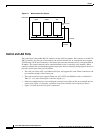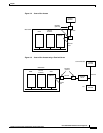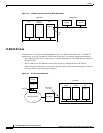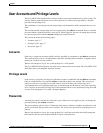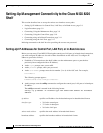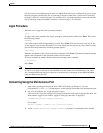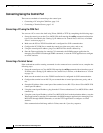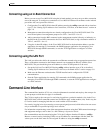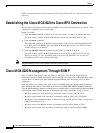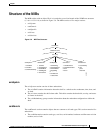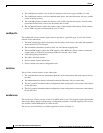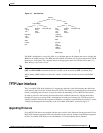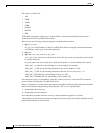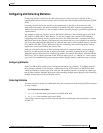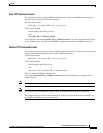
3-12
Cisco MGX 8220 Installation and Configuration
Release 5.0, Part Number 78-6430-03 Rev. D0, November 2003
Chapter
Establishing the Cisco MGX 8220 to Cisco BPX Connection
Each CLI command and its syntax and privilege level is provided in the Cisco MGX 8220 Command
Reference.
Establishing the Cisco MGX 8220 to Cisco BPX Connection
This procedure must be performed on the Cisco BPX at both ends of the connection (“A” and “B”). This
connection is established only once per shelf.
On the Cisco BPX
1. Enter the uptrk command to enable the T3 line that connects to your Cisco MGX 8220 shelf.
For trunk number, specify the BNI trunk number used for the Cisco MGX 8220 T3 line.
2. Enter the cnftrk command.
This command configures the physical line parameters of the T3 line connecting the BNI in the
Cisco BPX switch and BNM in the Cisco MGX 8220 shelf. Refer to the Cisco WAN Switching
Command Reference for details.
3. Enter the addshelf command to enable the port to the Cisco MGX 8220 shelf.
For trunk number, specify the BNI trunk number used for the Cisco MGX 8220 T3 line. For
shelf-type, specify “A” for Cisco MGX 8220, specify the VPI (between 5 and 14) and VCI
(between 6 and 271) in the VPI and VCI fields.
Note The total number of cells for all queues should not exceed 10,000.
Cisco MGX 8220 Management Through SNMP
The Cisco MGX 8220 shelf provides the ability to manage the shelf through Simple Network
Management Protocol (SNMP) commands. These commands are issued from an SNMP Manager, which
accesses the Cisco MGX 8220 shelf either through the Ethernet port, the control port, or in-band
connection.
Each ASC and service module in the shelf contains an SNMP agent and a Management Information
Base (MIB) for that module. The SNMP agent responds to GET, GET NEXT, and SET commands
from the SNMP Manager, thereby providing the user with the ability to interrogate and update the MIB.
All messages from the SNMP manager are checked for the correct community string as follows:
• Messages to the active ASC must have a community string of AXIS_ASC_ACTIVE
• Messages to the standby ASC must have a community string of AXIS_ASC_STANDBY
• Messages to service module must have a community string of AXIS_SM-xx (where xx is the service
module slot number 5 to 14)
• Messages to the active BNM must have a community string of AXIS_BNM_ACTIVE
• Messages to the standby ASC must have a community string of AXIS_BNM_STANDBY



